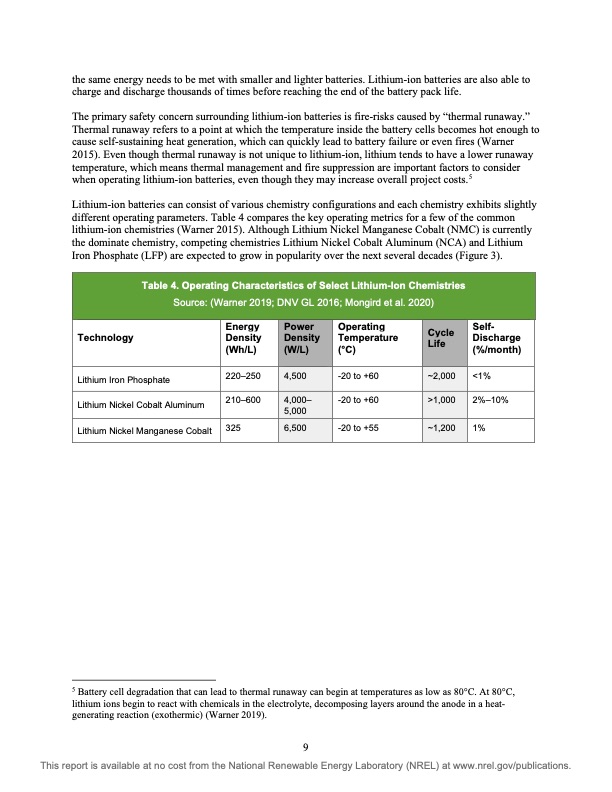
PDF Publication Title:
Text from PDF Page: 016
the same energy needs to be met with smaller and lighter batteries. Lithium-ion batteries are also able to charge and discharge thousands of times before reaching the end of the battery pack life. The primary safety concern surrounding lithium-ion batteries is fire-risks caused by “thermal runaway.” Thermal runaway refers to a point at which the temperature inside the battery cells becomes hot enough to cause self-sustaining heat generation, which can quickly lead to battery failure or even fires (Warner 2015). Even though thermal runaway is not unique to lithium-ion, lithium tends to have a lower runaway temperature, which means thermal management and fire suppression are important factors to consider when operating lithium-ion batteries, even though they may increase overall project costs.5 Lithium-ion batteries can consist of various chemistry configurations and each chemistry exhibits slightly different operating parameters. Table 4 compares the key operating metrics for a few of the common lithium-ion chemistries (Warner 2015). Although Lithium Nickel Manganese Cobalt (NMC) is currently the dominate chemistry, competing chemistries Lithium Nickel Cobalt Aluminum (NCA) and Lithium Iron Phosphate (LFP) are expected to grow in popularity over the next several decades (Figure 3). Table 4. Operating Characteristics of Select Lithium-Ion Chemistries Source: (Warner 2019; DNV GL 2016; Mongird et al. 2020) Energy Density (Wh/L) Power Density (W/L) Operating Temperature (°C) Self- Discharge (%/month) Technology Cycle Life Lithium Iron Phosphate Lithium Nickel Cobalt Aluminum 220–250 4,500 4,000– -20 to +60 ~2,000 <1% 210–600 5,000 -20 to +60 >1,000 2%–10% Lithium Nickel Manganese Cobalt 325 6,500 -20 to +55 ~1,200 1% 5 Battery cell degradation that can lead to thermal runaway can begin at temperatures as low as 80°C. At 80°C, lithium ions begin to react with chemicals in the electrolyte, decomposing layers around the anode in a heat- generating reaction (exothermic) (Warner 2019). 9 This report is available at no cost from the National Renewable Energy Laboratory (NREL) at www.nrel.gov/publications.PDF Image | USAID GRID-SCALE ENERGY STORAGE TECHNOLOGIES PRIMER

PDF Search Title:
USAID GRID-SCALE ENERGY STORAGE TECHNOLOGIES PRIMEROriginal File Name Searched:
76097.pdfDIY PDF Search: Google It | Yahoo | Bing
Turbine and System Plans CAD CAM: Special for this month, any plans are $10,000 for complete Cad/Cam blueprints. License is for one build. Try before you buy a production license. More Info
Waste Heat Power Technology: Organic Rankine Cycle uses waste heat to make electricity, shaft horsepower and cooling. More Info
All Turbine and System Products: Infinity Turbine ORD systems, turbine generator sets, build plans and more to use your waste heat from 30C to 100C. More Info
CO2 Phase Change Demonstrator: CO2 goes supercritical at 30 C. This is a experimental platform which you can use to demonstrate phase change with low heat. Includes integration area for small CO2 turbine, static generator, and more. This can also be used for a GTL Gas to Liquids experimental platform. More Info
Introducing the Infinity Turbine Products Infinity Turbine develops and builds systems for making power from waste heat. It also is working on innovative strategies for storing, making, and deploying energy. More Info
Need Strategy? Use our Consulting and analyst services Infinity Turbine LLC is pleased to announce its consulting and analyst services. We have worked in the renewable energy industry as a researcher, developing sales and markets, along with may inventions and innovations. More Info
Made in USA with Global Energy Millennial Web Engine These pages were made with the Global Energy Web PDF Engine using Filemaker (Claris) software.
Sand Battery Sand and Paraffin for TES Thermo Energy Storage More Info
| CONTACT TEL: 608-238-6001 Email: greg@infinityturbine.com | RSS | AMP |